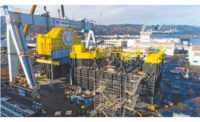Seawater desalination is an energy-hungry process only a few wealthy seaside cities can afford. In 18 months, a new company hopes to bring to market an ocean-wave-powered process that supplies potable water—cutting costs and limiting pollution, as compared to traditional desalination systems that require power plants.
Atmocean Inc., Santa Fe, N.M., has conducted 29 sea trials since its founding in 2006. In collaboration with Sandia National Laboratory and Reytek Corp., both of Albuquerque, its recent trials were in the Pacific Ocean, off Peru, in 2015. Following modifications, the company tested a 1⁄8-scale model at Texas A&M in February. Reytek is preparing a full-scale test unit for deployment this year off Marystown, Newfoundland.
The so-far-unbranded unit is similar to an oscillating water column but without the generator, says Phil Fullam, Reytek senior engineer. “The basic concept is a water pump actuated by wave motion.," he says.
Each pump is a piston mounted on a base on the ocean floor and topped by a buoy. “As a wave passes, the buoy ingests seawater, and as the buoy settles, it pumps seawater through hydraulic lines back to shore, where it enters the zero-electricity desalination process,” says Tim Koehler, senior member of technical staff at Sandia.
On shore, 14% of the volume is diverted for reverse-osmosis processing; the pressure of the diverted water is boosted to 900 lb per sq in. from the ocean pump’s 180 PSI, with no other energy inputs.
“This system is designed to operate so that you can deploy it with a small fishing boat,” Fullam says. “When we did a deployment [off] Peru, the units were towed out to the location with dinghies driven by an outboard motor, because each component is quite small and doesn’t require any heavy lifting.”
The buoy is about 3 meters in diameter, and the pump is light. “You can go to a remote location, hire local individuals, and with levers and beams and a couple of come-alongs, you can get the system out where you need it,” he notes.
The pumps are deployed in series of five, attached to free-floating platforms called Variable Sea Anchors, which are connected beneath the pump and provide drag for the buoys.
Moored by cables, the pump assemblies are anchored on each end to a 6- to 7-ton concrete block that rests on the sea floor. Tailored to the requirements of a specific location, a typical array has 15 to 25 pumps, depending on the water requirements, Fullam says.
While the surface area occupied by an array makes the area non-navigable, the array also creates an attractive marine habitat. “Every time we’ve done a deployment, we’ve noticed there’s an influx of ocean life,” he says.
Atmocean will start by owning and operating its systems to demonstrate the technology and ensure end-product profitability, says Chris White, chief operating officer.
The company estimates a current capital expenditure below $1 million, delivered and installed, for an entire array, an integrated multitrophic system and a desalination unit. “We are hopeful that our Newfoundland tests will bring us to a commercial-ready stage,” White says.


_ENRready.jpg?height=200&t=1668019257&width=200)

Post a comment to this article
Report Abusive Comment